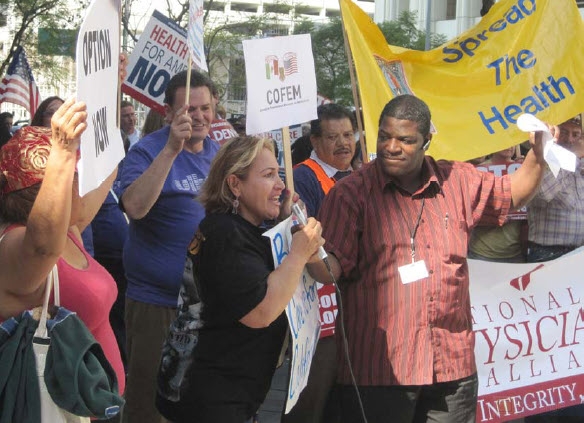
California is also a harbinger of the social dynamics soon to sweep other parts of the nation as a result of this demographic change. While most analysts have focused on the shrinking white (once) majority, another important story has been the growing proximity of African Americans and the state’s immigrants. Increasingly, immigrants, particularly Latinos, have moved into traditionally Black neighborhoods, transforming (and often revitalizing) the urban landscape with new businesses, new churches, and new ways of living – but also generating a palpable sense of loss as the hood has become the barrio and Black political and cultural influence has eroded.
Adding to this are economic concerns in a state economy shaken not just by the current bout of high unemployment but also by longer-term processes of deindustrialization and dislocation. In this context, immigrants have helped to prop up sagging businesses, providing new consumer demand as well as loyal and often less expensive labor. But while immigrant employees have revitalized California’s economy and labor movement, some residents have rightfully worried about the negative impacts on native-born employment and wages, particularly of less-skilled and less-connected Black workers.
A report by USC shows that as African Americans and immigrants increasingly bump up against each other in their neighborhoods and the economy, the media has focused on the tensions and conflicts. The targeting of Blacks by immigrant gang members, the hostility of older African American residents to newcomers, and the loss of Black political power as Latinos gain ground all make for spectacular reporting. But missing in that portrayal are the daily accommodations in our neighborhoods and schools, the common struggles to reduce disproportionate incarceration, and the organizing around housing, jobs and the environment that has crossed the boundaries of race. Missed is the story of collaboration in the face of conflict.

Many African American neighborhoods have experienced a sharp increase in immigrant residents, some with the Black populations remaining relatively stable, some experiencing a sharp decline. These latter communities may be especially important to understand and assist as there is often a mismatch between existing African American community institutions and new immigrant populations.
Black and immigrant presence have increased in a series of neighborhoods – much like in the American South. One set of both populations is moving to older suburban areas for better school opportunities. Another set moved to the suburban fringe where Blacks and immigrants found cheaper housing but are now stranded amongst foreclosures and unemployment.
The immigrants mixing it up with African Americans are not just Latino. Asians make up a sizable share of immigrants in California. This is especially true in neighborhoods where both populations are newly arrived, but also in places where there has been a historical presence of African Americans.
Despite the differences in neighborhood types, communities are actually more united than divided by the facts of high need, and significant disadvantage. Leadership development is key but the first step is creating the space for new and honest dialogue about what is shared and what is different.
Source: Center for the Study of Immigration Integration at USC, “All Together Now? African-Americans, Immigrants and the Future of California,” October 2011.